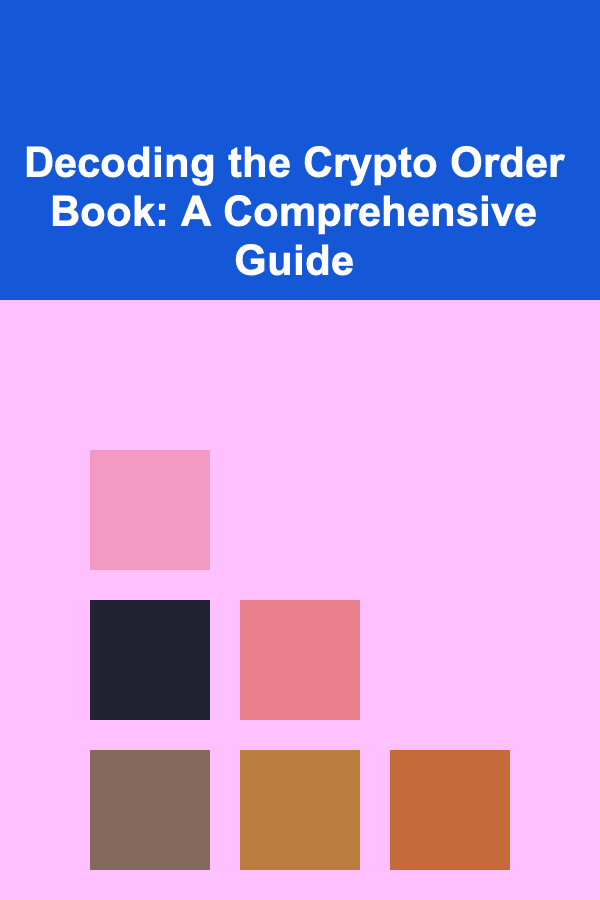
Decoding the Crypto Order Book: A Comprehensive Guide
ebook include PDF & Audio bundle (Micro Guide)
$12.99$10.99
Limited Time Offer! Order within the next:

The cryptocurrency order book is a cornerstone of digital asset trading, acting as a real-time log of buy and sell orders for a specific cryptocurrency pair. Understanding how to interpret an order book is crucial for anyone participating in the crypto market, whether a seasoned trader or a beginner. It provides valuable insights into market sentiment, potential price movements, liquidity, and the overall supply and demand dynamics of a particular cryptocurrency. This comprehensive guide delves deep into the intricacies of crypto order books, equipping you with the knowledge to make more informed trading decisions.
What is a Crypto Order Book?
At its core, an order book is an electronic record of all outstanding buy (bid) and sell (ask) orders for a specific cryptocurrency. It's essentially a waiting list of traders willing to buy or sell an asset at a specific price. Crypto exchanges use order books to match buyers and sellers, facilitating trades based on pre-defined parameters. The order book is dynamically updated in real-time, reflecting the constant flow of new orders, cancellations, and filled orders.
Think of it like an auction house, but instead of an auctioneer, the exchange's matching engine automatically pairs up the highest bids and lowest asks. This process ensures a transparent and efficient market for cryptocurrencies.
The Structure of a Crypto Order Book
Order books are typically organized into two main sections, often presented side-by-side:
- Bids (Buy Orders): This side of the order book lists all outstanding buy orders for the cryptocurrency. Orders are typically displayed from the highest bid price down to the lowest. Traders place bids when they believe the price will increase.
- Asks (Sell Orders): This side displays all outstanding sell orders. Orders are presented from the lowest ask price up to the highest. Traders place asks when they believe the price will decrease or when they want to take profits.
Each entry in the order book typically includes the following information:
- Price: The price at which the order is placed.
- Size (Quantity): The amount of the cryptocurrency the order is for.
- Cumulative Size: The total accumulated size of all orders at and above (for bids) or at and below (for asks) a particular price level. This is a very important piece of information for visualizing market depth.
The difference between the highest bid price and the lowest ask price is known as the spread. A narrower spread generally indicates higher liquidity, making it easier to execute trades quickly and at the desired price. A wider spread can suggest lower liquidity and potentially higher price slippage.
Key Terms to Understand
Before diving deeper into order book analysis, it's essential to familiarize yourself with some key terms:
- Market Order: An order to buy or sell immediately at the best available price in the order book. Market orders are executed instantly but can be subject to price slippage, especially in less liquid markets.
- Limit Order: An order to buy or sell at a specific price. The order will only be filled if the market price reaches the specified limit price. Limit orders offer more control over the execution price but may not be filled if the market doesn't reach the desired level.
- Stop-Loss Order: An order to sell when the price reaches a specific stop price. This is used to limit potential losses on a trade. Once the stop price is triggered, the order typically becomes a market order.
- Stop-Limit Order: Similar to a stop-loss order, but instead of becoming a market order, it becomes a limit order once the stop price is reached. This offers more control over the selling price but also increases the risk of the order not being filled.
- Market Depth: A visual representation of the order book, showing the volume of buy and sell orders at different price levels. Market depth helps traders assess the liquidity and potential price impact of large orders.
- Slippage: The difference between the expected price of a trade and the actual price at which it is executed. Slippage can occur when the order book lacks sufficient liquidity to fill the order at the desired price.
- Spoofing: A manipulative trading tactic where traders place large orders with no intention of filling them. The goal is to create artificial buying or selling pressure to influence the price, and then cancel the orders before they are executed. Spoofing is illegal in regulated markets, but can occur in the less regulated cryptocurrency space.
- Layering: A trading strategy where traders place multiple limit orders at different price levels, both above and below the current market price. This can create the illusion of strong support or resistance and potentially influence other traders' decisions.
- Hidden Orders (Iceberg Orders): Large orders that are partially hidden from the order book. Only a portion of the order is displayed, while the rest remains hidden. This prevents other traders from knowing the full extent of the trader's intentions and avoids potentially moving the market against them before the order is filled.
How to Interpret the Order Book: Practical Examples
Now, let's explore some practical examples of how to interpret the order book and use it to inform your trading decisions:
1. Identifying Support and Resistance Levels
Large clusters of buy orders on the bid side can act as support levels. If the price approaches these levels, the buying pressure can prevent further price declines. Conversely, large clusters of sell orders on the ask side can act as resistance levels. As the price approaches these levels, the selling pressure can prevent further price increases.
Imagine you're looking at the BTC/USDT order book. You notice a significant number of buy orders clustered around $26,000. This could indicate a strong support level. If the price drops towards $26,000, you might expect to see buying pressure prevent a further decline. On the other hand, a large number of sell orders around $27,000 would suggest a resistance level. Breaking through these levels can indicate a trend reversal or continuation, depending on the context.
However, remember that these levels are not guaranteed. "Whale" activity can break through these levels unexpectedly. Use other indicators in conjunction with order book analysis to confirm your interpretations.
2. Gauging Market Sentiment
The relative size and distribution of bids and asks can provide insights into overall market sentiment. A significantly larger number of buy orders compared to sell orders might suggest bullish sentiment, indicating that more traders are optimistic about the price going up. Conversely, a larger number of sell orders might indicate bearish sentiment.
If you see a significant imbalance in the order book, with far more buy orders than sell orders, it could indicate that the market is leaning bullish. Traders are more eager to buy than to sell, suggesting a potential upward price movement. However, be cautious of "spoofing" -- large orders placed with no intention to fill, designed to manipulate sentiment. Look for consistency in the order book over time rather than reacting to isolated large orders.
3. Assessing Liquidity
The depth and density of the order book indicate the liquidity of the cryptocurrency. A deep order book with many orders at various price levels suggests high liquidity, making it easier to execute large trades without significant price slippage. A shallow order book with few orders indicates low liquidity, making it more susceptible to price fluctuations and slippage.
A deep order book for Bitcoin with numerous buy and sell orders within a narrow price range indicates high liquidity. You can likely buy or sell a significant amount of Bitcoin without drastically affecting the price. Conversely, a smaller altcoin with a sparse order book might experience significant price swings with even relatively small trades. Understanding liquidity is crucial for managing risk and avoiding unwanted slippage.
4. Identifying Potential Price Movements
By observing the order book dynamics, you can anticipate potential price movements. For example, if you see a large number of sell orders accumulating at a certain price level, it might suggest that the price is likely to face resistance at that level. Conversely, a rapid removal of sell orders could indicate a potential breakout to the upside.
Imagine the price of Ethereum is approaching a resistance level at $1,800. You notice that a large number of sell orders are being placed at this price. This suggests that many traders are looking to sell at that level, potentially preventing the price from breaking through. However, if you observe a sudden disappearance of these sell orders, it could indicate that traders are anticipating a breakout and are removing their orders to avoid missing out on the potential gains.
5. Detecting Order Book Manipulation
While not always easy to detect, order book manipulation techniques like spoofing and layering can sometimes be identified by carefully analyzing the order book. Rapidly appearing and disappearing large orders, or a suspicious pattern of orders being placed at different price levels, could be signs of manipulation.
You might notice a very large buy order suddenly appearing just below the current market price, only to be canceled moments later. This could be an attempt to create artificial buying pressure and lure other traders into buying. Be wary of such patterns and avoid making decisions based solely on these suspicious orders.
6. Using Cumulative Order Book Data
Many trading platforms offer cumulative order book data. This is a representation of the total order size at or better than a given price. This is very powerful for identifying key levels of support and resistance. Looking at the cumulative volume allows a trader to avoid being tricked by orders placed closer to the best bid/ask, but may have little real depth.
A cumulative bid size of 100 BTC at $26,000 means that there are a total of 100 BTC worth of buy orders sitting at or above that price. This gives a much better indication of the real demand at that level than simply looking at the single largest order. Comparing the cumulative bid and ask volume at different prices helps to identify areas of high and low liquidity.
Tools and Resources for Order Book Analysis
Several tools and resources can assist you in analyzing crypto order books:
- Exchange Trading Platforms: Most cryptocurrency exchanges provide real-time order book data, often with interactive charts and visualization tools.
- Third-Party Trading Platforms: Platforms like TradingView, Coinigy, and others offer advanced order book analysis tools and charting capabilities.
- Order Book APIs: Application Programming Interfaces (APIs) allow you to programmatically access and analyze order book data, enabling you to create custom trading strategies and algorithms.
- Market Depth Charts: Visualize order book data through depth charts, which provide a graphical representation of the volume of buy and sell orders at different price levels.
Limitations of Order Book Analysis
While order book analysis can be a valuable tool, it's essential to be aware of its limitations:
- Manipulation: As mentioned earlier, order books can be manipulated through spoofing and layering, potentially leading to inaccurate interpretations.
- Hidden Orders: The presence of hidden orders (iceberg orders) can distort the visible order book data, making it difficult to assess the true supply and demand dynamics.
- Flash Crashes: Unexpected market events like flash crashes can invalidate order book information and lead to rapid price swings.
- Lag: While order books are updated in real-time, there can be a slight delay between the actual market activity and the displayed data. This lag can be critical for high-frequency traders.
- Emotion: Humans make the orders in the order book. Therefore, fear and greed influence the information shown. The order book can reflect, and amplify, general market fear, uncertainty, and doubt (FUD) or extreme optimism.
- Doesn't Account for Off-Chain Activity: Order books only reflect the buy and sell interest that is present on the exchange. They don't account for Over-the-Counter (OTC) trades, private deals, or other off-chain activity that can significantly influence price.
Best Practices for Order Book Analysis
To maximize the effectiveness of order book analysis, consider these best practices:
- Combine with Other Indicators: Don't rely solely on order book analysis. Use it in conjunction with other technical indicators, such as moving averages, RSI, and MACD, to confirm your observations.
- Analyze Historical Data: Studying past order book data can help you identify patterns and understand how the market typically reacts to different situations.
- Focus on Liquid Markets: Order book analysis is more reliable in highly liquid markets with deep order books. In illiquid markets, the data can be more volatile and susceptible to manipulation.
- Be Aware of Market News: Stay informed about relevant news and events that could impact the price of the cryptocurrency you are trading. News events can often override order book signals.
- Practice Risk Management: Always use appropriate risk management techniques, such as setting stop-loss orders and managing your position size, to protect your capital.
- Use Multiple Order Books: Compare the order books across multiple exchanges. Significant discrepancies between order books can indicate arbitrage opportunities or potential manipulation.
- Adapt Your Strategy: The cryptocurrency market is constantly evolving. Be prepared to adapt your order book analysis strategy as market conditions change.
Advanced Order Book Analysis Techniques
For more experienced traders, here are some advanced order book analysis techniques:
- Order Flow Analysis: This involves analyzing the stream of incoming and outgoing orders to identify trends and predict future price movements. It focuses on the rate at which orders are being placed and filled, not just the static snapshot of the order book.
- Volume Profile Analysis: This technique uses volume data to identify key price levels where significant trading activity has occurred in the past. These levels can act as support or resistance in the future. Volume profile analysis can be combined with order book analysis for a more comprehensive view of market dynamics.
- Heatmaps: Some platforms offer heatmap visualizations of order book data, which can help you quickly identify areas of high buying or selling pressure.
- Machine Learning: Advanced traders are starting to use machine learning algorithms to analyze order book data and identify patterns that are difficult for humans to detect. This can be used to develop automated trading strategies.
Conclusion
Interpreting crypto order books is a valuable skill that can significantly improve your trading decisions. By understanding the structure of the order book, familiarizing yourself with key terms, and applying the techniques discussed in this guide, you can gain a deeper understanding of market sentiment, liquidity, and potential price movements. However, it's crucial to remember that order book analysis is not a foolproof strategy and should be used in conjunction with other technical indicators and risk management techniques. The crypto market is dynamic and complex, so continuous learning and adaptation are essential for success. By consistently practicing and refining your order book analysis skills, you can gain a competitive edge and navigate the crypto market with greater confidence.

How to Choose the Best Pet Supplies Products for Your Dropshipping Store
Read More
How to Create a Tool Drawer for Cooking Essentials
Read More
How to Keep Your Car Organized for Family Trips
Read More
How To Prepare for Managerial Interviews
Read More
How to Develop AR for Field Service Technicians
Read More
How to Authenticate Antique Jewelry
Read MoreOther Products

How to Choose the Best Pet Supplies Products for Your Dropshipping Store
Read More
How to Create a Tool Drawer for Cooking Essentials
Read More
How to Keep Your Car Organized for Family Trips
Read More
How To Prepare for Managerial Interviews
Read More
How to Develop AR for Field Service Technicians
Read More